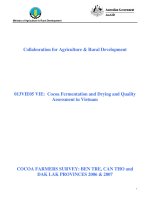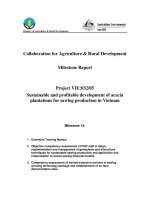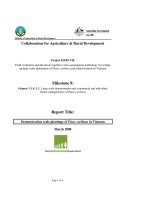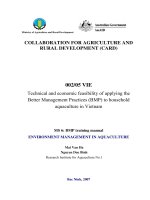Collaboration for Agriculture & Rural Development: Field evaluation and advanced vegetative mass-propagation technology for scaling up high-value plantations of Pinus caribaea and related hybrids in Vietnam - Milestone 9 " pot
Bạn đang xem bản rút gọn của tài liệu. Xem và tải ngay bản đầy đủ của tài liệu tại đây (53.15 KB, 7 trang )
Page 1 of 6
Ministry of Agriculture & Rural Development
Collaboration for Agriculture & Rural Development
Project 033/05 VIE
Field evaluation and advanced vegetative mass-propagation technology for scaling
up high-value plantations of Pinus caribaea and related hybrids in Vietnam
Milestone 9:
Outputs 3.1 & 3.2: Large scale demonstration and community and individual
farmer managed sites of Pinus caribaea
Report Title:
Demonstration scale plantings of Pinus caribaea in Vietnam
March 2008
Page 2 of 6
1.0 INTRODUCTION
CARD Project 033/VIE seeks to review existing experience with and performance of several
tropical conifer species in Vietnam, particularly Caribbean Pine, and to establish further trials of
improved genetic material, including hybrids.
The project will also provide capacity building for forest research institutions relating to Pinus
tree improvement and mass propagation systems via training in Queensland and Vietnam,
development of small-scale hedge and nursery infrastructure, and a study tour to Australia,
involving forest managers and researchers.
Finally, the project will build awareness among large and small-scale forest growers including
ethnic minorities, through the establishment of collaborative demonstration plantings in priority
regions for Pinus plantation expansion in Vietnam, supported by appropriate training.
Milestone 8 Report provides a summary of existing Pinus trials throughout Vietnam and
highlights the excellent potential of Pinus caribaea in most regions.
Milestone 4 Report provides information regarding the establishment of several new
experimental scale trials of various Pinus taxa including Pinus caribaea and related hybrids.
This Milestone 9 Report relates to Outputs 3.1 and 3.2 of the Project covering the establishment
of demonstration scale plantings of Pinus caribaea with commercial forest growers and
community and individual farmers.
2.0 SELECTION OF DEMONSTRATION SITES
The selection of sites for demonstration sites is largely dependent on the level of co-operation,
in-kind resources and long-term commitment to be provided by participating landholders.
During the Project period, demonstration sites have been planted at the following sites:
• Lac Duong, Lam Dong Province
• Dak P’Lao, Dak Nong Province
• Van Diem, Nam Dan, Nghe An Province
• Cam Lo, Dong Ha, Quang Tri Province
The latter two sites were planted adjacent to genetic trials (Refer Milestone 4 Report).
Other potential sites discussed with project partners included Dak To (Kon Tum Province) and
Ngoc Lac (Thanh Hoa Province), however plant shortages and difficulties in negotiating short
and long-term in-kind resources prevented these sites being established. In the longer term,
beyond the life of this Project, it is hoped that further demonstration trials will be established
using cuttings becoming available from the pilot nurseries.
The following sections provide an overview of the four sites planted to date.
3.0 FOREST COMPANY TRIAL, LAM DONG PROVINCE
Pinus kesiya occurs naturally at high elevations (above around 900m) throughout the Central
Highlands Region of Vietnam. For example it is the dominant pine in natural stands that are
visible from the main range road up to Dalat, the capital of Lam Dong Province (Refer A1 & A2
in Attachment A). The forests near Dalat, and other high quality stands of P. kesiya, are
protected within Lam Dong Province for watershed protection and conservation purposes. In
addition to native forest areas, there are extensive P. kesiya plantations throughout Lam Dong
Page 3 of 6
Province and other Central Highland Provinces, although the growth and form of these
plantations is inferior to that observed in natural stands (A3 & A4). Pinus kesiya from both
natural forest and plantation sources is an important source of building timber. (A5 – A8).
Unfortunately, the rapid expansion of coffee plantations in recent years has resulted in the
clearing of both natural and plantation forests of P. kesiya. (A9 & A10).
In parts of Lam Dong Province, management responsibility for large areas of Pinus kesiya
natural forest is transferring from the Government of Vietnam (Forestry Department) to private
landholders and companies via the issue of long-term leases. Prior to the issue of long-term
leases, an inventory of the forest (and other) resources within a particular lease area is conducted
to form the basis of a long-term management plan. For example, a long-term management plan,
ratified as part of the lease agreement, might include the following land use categories:
• High quality natural forest –for watershed protection and conservation (no logging)
• Medium quality forest – for periodic timber harvest and enrichment planting
• Degraded forest and grassland – to be re-planted with high-yielding plantation species
• Other cleared areas – for cattle grazing
• Specific sites – for eco-tourism or other retail opportunities
Staff from the Lam Dong Forest Research Centre are involved in the development of many such
management plans for companies seeking long-term leases over forested areas in Lam Dong
Province. Against this background, it was decided that a demonstration planting based on one of
the new long-term company lease areas would serve as a useful demonstration site for other
companies seeking to invest in the region. Details of the lease and demonstration planting are
outlined in Table 1 and illustrated in images A11 to A23.
Table 1: Forest lease area and associated pine demonstration planting
Item Description
District &
Province
Lac Duong, Lam Dong Province
Area: 1,513 km
2
Population density: 16 persons / km
2
Location
Approximately 45 minute drive north-east of Dalat on route 417 ( joins
new highway to Nha Trang)
Adjacent
communes and
villages
Da Chais and Da Nhim Communes. The adjoining Dong Mang village,
part of the Da Chais commune, supports 23 ethnic minority families
with a total population of 226 people.
Lease holder
Paradise Company (Công Ty TNHH Tiên Thai)
Latitude
12° 10’ 00’’N (approximate)
Lease term
50 years (from 2007)
Longitude
108° 28’00’’E (approximate)
Elevation (m)
1,500
Climate
1,896 mm annual rainfall (rainy season May – October)
Average annual temperature : 18° C
Average annual humidity: 85%
Soil
Deep, red, well-drained, ferralitic
Demonstration
pine area
Species: Pinus caribaea var. hondurensis (PCH) – non select –
Queensland
Pinus kesiya
Area: Approximately 10 ha
Date planted: October 2007
Spacing: Approximately 3m x 3m (1,111 trees per hectare)
Page 4 of 6
4.0 SMALL SCALE COMMUNITY AND INDIVIDUAL FARMER TRIALS
A small ethnic minority village near Dak PLao was identified during the initial Project planning
visit as a potentially suitable site to establish some pine demonstration trials with the local
community and individual farmers.
Dak PLao is located in Dak Nong District within Dak Nong Province (previously part of Dak
Lak Province) just over the border from Lam Dong Province and about 5 km north of the
Highway 28 border bridge
1
on the Da Dang River. The District extends over 2,131 km
2
and
supports a low density population averaging only 29 persons/ km
2
.
The community comprises a mix of indigenous ethnic minority people as well as ethnic minority
families from Vietnam’s northern mountainous areas that have recently re-settled in the area
(Images B1 to B4). Staff from the Lam Dong Forest Research Centre are working closely with
these groups as part of a broader community forestry project based on the surrounding forest.
Image B5/5a is a map/legend showing the different forest types and planned uses for the Project
Forest. The forest, totalling approximately 3,000 hectares, includes primary rainforest and pine
forest, secondary forest, bamboo forest and degraded regrowth and grasslands (B6 – B9).
A three year old PCH planting near the Dak PLao township is showing impressive growth (B10
& B11) and has provided encouragement for further planting of this pine in the local area. In
December 2007 the CARD Project team inspected a recently planted Pinus caribaea var.
hondurensis (PCH) demonstration trial on a previously cleared, very steep slope near the village
(B12 – B14). Survival appeared quite good although follow up manual weed control will be
required to promote good early growth.
As part of the community forest project, a new forest station and forest nursery is being
constructed on the edge of the Project Forest (B15 – B17). Once completed, it is the intention of
the local managers to trial some of the nursery techniques developed as part of this CARD
Project and to encourage the broader scale planting of Pinus caribaea var. hondurensis on steep
degraded areas within the Project Forest Area in conjunction with the local community and
individual farmers.
5.0 DEMONSTRATION PLANTINGS ADJACENT TO GENETIC TRIALS
As mentioned earlier, two additional demonstration sites have recently been planted in
conjunction with structured genetic trials. The genetic trials will enable the provision of
statistically rigorous data while the demonstration plantings will enable the performance of
several species and hybrids to be assessed in larger block plantings. Table 2 provides summary
information regarding the two demonstration plantings. Attachments C and D are layout maps
for the site in Nghe An and Quang Tri Province respectively. The primary commercial pine
grown in these areas is Pinus merkussii.
1
This bridge will be submerged following construction of a planned hydro-dam in the vicinity
Page 5 of 6
Table 2: Summary details for demonstration plantings in Nghe An and Quang Tri Provinces
Nghe An Province site Quang Tri Province site
Location Van Dien, Nam Dan Cam Lo, Dong Ha
Local management Management Board of Nam
Dan Forest Protected Areas
Research Centre for North
Central Vietnam
Latitude (approximate) 18° 03’ 13’’N 16° 48’ 39’’N
Longitude (approximate) 105° 09’ 09’’E 107° 00’ 17’’E
Date planted 18/12/07 15/12/07
Spacing 3m x 3m 3m x 3m
Site preparation Clear vegetation, remove stumps and plough
Fertilizer (3 kg well-composted cow
manure + 100g NPK)/tree
200g NPK/tree
Area 2.7 ha 1.5 ha (less genetics trial)
Species in demonstration pine
trial
P. merkussii
PCH (Dai Lai)
PCH (Queensland)
PEE x PCH F2 hybrid (Qld)
P. merkussii
P.massoniana
PCH (Dai Lai)
PCH (Queensland)
PEE x PCH F2 hybrid (Qld)
PCH x PCB (Qld)
PCH x PCC (Qld)
Deleted: Annual Rainfall
Deleted: ¶
[1]
Page 6 of 6
6.0 CONTACTS
Project Management, Vietnam Project Management, Australia
Mr Phi Hong Hai
Deputy Director
Research Centre for Forest Tree Improvement
Dong Ngac, Tu Liem, Ha Noi
Ph: 84 (0) 4 8389 813
Fax 84 (0) 4 836 2280
Mr Ian Last
Manager, Plantation Development and
Innovation
Forestry Plantations Queensland
P O Box 1339,GYMPIE, Queensland, 4570
Ph: 61 (0) 754 820 891
Fax: 61 (0) 7 5482 3430
Demonstration Sites
“Paradise” & Dak PLao, Lam Dong Province
Mr Hua Vinh Tung
Director
Lam Dong Forest Research Centre
9 Hung Vuong, Dalat, LAM DONG
Ph: 063 822 131 Fax: 063 829 852
Van Dien, Nam Dan, Nghe An Province
Management Board of Nam Dan Forest Protected Areas
Mr Le Dinh Minh
Tel: 0380 822 106
Cam Lo, Dong Ha, Quang Tri Province
Research Centre for North Central Vietnam
Mr Hoang Minh Tam
Page 5: [1] Deleted Lasti 3/10/2008 12:22:00 PM
Annual Rainfall









